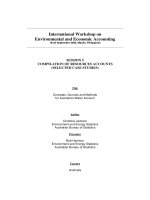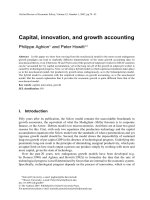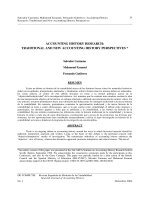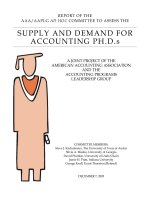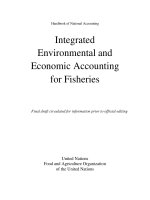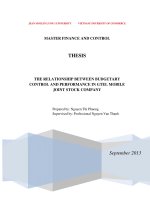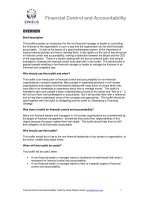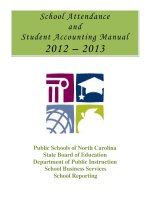budgetary control and responsibilty accounting
Bạn đang xem bản rút gọn của tài liệu. Xem và tải ngay bản đầy đủ của tài liệu tại đây (260.89 KB, 34 trang )
BUDGETARY CONTROL AND
RESPONSIBILITY ACCOUNTING
TRUE-FALSE STATEMENTS
1. Budget reports comparing actual results with planned objectives should be prepared only
once a year.
2. If actual results are different from planned results, the difference must always be
investigated by management to achieve effective budgetary control.
3. Certain budget reports are prepared monthly whereas others are prepared more frequently
depending on the activities being monitored.
4. The master budget is not used in the budgetary control process.
5. A master budget is most useful in evaluating a manager's performance in controlling costs.
6. A static budget is one that is geared to one level of activity.
7. A static budget is changed only when actual activity is different from the level of activity
expected.
8. A static budget is most useful for evaluating a manager's performance in controlling variable
costs.
9. A flexible budget can be prepared for each of the types of budgets included in the master
budget.
10. A flexible budget is a series of static budgets at different levels of activities.
11. Flexible budgeting relies on the assumption that unit variable costs will remain constant
within the relevant range of activity.
12. Total budgeted fixed costs appearing on a flexible budget will be the same amount as total
fixed costs on the master budget.
13. A flexible budget is prepared before the master budget.
14. The activity index used in preparing a flexible budget should not influence the variable costs
that are being budgeted.
15. A formula used in developing a flexible budget is: Total budgeted cost = fixed cost + (total
variable cost per unit X activity level).
16. Flexible budgets are widely used in production and service departments.
17. A flexible budget report will show both actual and budget cost based on the actual activity
level achieved.
Test Bank for Managerial Accounting, Second Edition
7-2
18. Management by exception means that management will investigate areas where actual
results differ from planned results if the items are material and controllable.
19. Policies regarding when a difference between actual and planned results should be
investigated are generally more restrictive for noncontrollable items than for controllable
items.
20. A distinction should be made between controllable and noncontrollable costs when
reporting information under responsibility accounting.
21. Cost centers, profit centers, and investment centers can all be classified as responsibility
centers.
22. More costs become controllable as one moves down to each lower level of managerial
responsibility.
23. In a responsibility accounting reporting system, as one moves up each level of responsibility
in an organization the responsibility reports become more summarized and show less
detailed information.
24. A cost item is considered to be controllable if there is not a large difference between actual
cost and budgeted cost for that item.
25. The terms "direct fixed costs" and "indirect fixed costs" are synonymous with "traceable
costs" and "common costs," respectively.
26. A cost center incurs costs and generates revenues and cost center managers are evaluated
on the profitability of their centers.
27. Controllable margin is subtracted from controllable fixed costs to get net income for a profit
center.
28. The formula for computing return on investment is controllable margin divided by average
operating assets.
29. The denominator in the formula for calculating the return on investment includes operating
and nonoperating assets.
*30. Residual income is the income that remains after subtracting from controllable margin the
minimum rate of return on a company’s average operating assets.
Answers to True-False Statements
Item
Ans.
Item
Ans.
Item
Ans.
Item
Ans.
Item
Ans.
Item
Ans.
1.
F
6.
T
11.
T
16.
T
21.
T
26.
F
2.
F
7.
F
12.
T
17.
T
22.
F
27.
F
3.
T
8.
F
13.
F
18.
T
23.
T
28.
T
4.
F
9.
T
14.
F
19.
F
24.
F
29.
F
5.
F
10.
T
15.
T
20.
T
25.
T
*30.
T
Budgetary Control and Responsibility Accounting
7-3
Test Bank for Managerial Accounting, Second Edition
7-4
MULTIPLE CHOICE QUESTIONS
31. A major element in budgetary control is
a. the preparation of long-term plans.
b. the comparison of actual results with planned objectives.
c. the valuation of inventories.
d. approval of the budget by the stockholders.
32. Budget reports should be prepared
a. daily.
b. monthly.
c. weekly.
d. as frequently as needed.
33. On the basis of the budget reports,
a. management analyzes differences between actual and planned results.
b. management may take corrective action.
c. management may modify the future plans.
d. all of these.
34. The purpose of the departmental overhead cost report is to
a. control indirect labor costs.
b. control selling expense.
c. determine the efficient use of materials.
d. control overhead costs.
35. The purpose of the sales budget report is to
a. control selling expenses.
b. determine whether income objectives are being met.
c. determine whether sales goals are being met.
d. control sales commissions.
36. The comparison of differences between actual and planned results
a. is done by the external auditors.
b. appears on the company's external financial statements.
c. is usually done orally in departmental meetings.
d. appears on periodic budget reports.
37. A static budget
a. should not be prepared in a company.
b. is useful in evaluating a manager's performance by comparing actual variable costs and
planned variable costs.
c. shows planned results at the original budgeted activity level.
d. is changed only if the actual level of activity is different than originally budgeted.
38. A static budget report
a. shows costs at only 2 or 3 different levels of activity.
b. is appropriate in evaluating a manager's effectiveness in controlling variable costs.
c. should be used when the actual level of activity is materially different from the master
budget activity level.
d. may be appropriate in evaluating a manager's effectiveness in controlling costs when
the behavior of the costs in response to changes in activity is fixed.
Budgetary Control and Responsibility Accounting
7-5
39. A static budget is appropriate in evaluating a manager's performance if
a. actual activity closely approximates the master budget activity.
b. actual activity is less than the master budget activity.
c. the company prepares reports on an annual basis.
d. the company is a not-for-profit organization
40. When budgeted and actual results are not the same amount, there is a budget
a. error.
b. difference.
c. anomaly.
d. by-product.
41. Top management's reaction to a difference between budgeted and actual sales often
depends on
a. whether the difference is favorable or unfavorable.
b. whether management anticipated the difference.
c. the materiality of the difference.
d. the personality of the top managers.
42. If costs are not responsive to changes in activity level, then these costs can be best
described as
a. mixed.
b. flexible.
c. variable.
d. fixed.
43. Assume that actual sales results exceed the planned results for the second quarter. This
favorable difference is greater than the unfavorable difference reported for the first quarter
sales. Which of the following statements about the sales budget report on June 30 is true?
a. The year-to-date results will show a favorable difference.
b. The year-to-date results will show an unfavorable difference.
c. The difference for the first quarter can be ignored.
d. The sales report is not useful if it shows a favorable and unfavorable difference for the
two quarters.
44. A static budget is appropriate for
a. variable overhead costs.
b. direct material costs.
c. fixed overhead costs.
d. none of these.
45. A flexible budget
a. is prepared when management can't agree on objectives for the company.
b. projects budget data for various levels of activity.
c. is only useful in controlling fixed costs.
d. cannot be used for evaluation purposes because budgeted data are adjusted to reflect
actual results.
Test Bank for Managerial Accounting, Second Edition
7-6
46. The master budget of Benedict Company shows that the planned activity level for next year
is expected to be 50,000 machine hours. At this level of activity, the following manufacturing
overhead costs are expected:
Indirect labor $360,000
Machine supplies 90,000
Indirect materials 105,000
Depreciation on factory building 75,000
Total manufacturing overhead $630,000
A flexible budget for a level of activity of 60,000 machine hours would show total
manufacturing overhead costs of
a. $741,000.
b. $630,000.
c. $756,000.
d. $681,000.
47. A department has budgeted monthly manufacturing overhead cost of $90,000 plus $3 per
direct labor hour. If a flexible budget report reflects $174,000 for total budgeted
manufacturing cost for the month, the actual level of activity achieved during the month was
a. 88,000 direct labor hours.
b. 28,000 direct labor hours.
c. 58,000 direct labor hours.
d. cannot be determined.
48. Which one of the following would be the same total amount on a flexible budget and a static
budget if the activity level is different for the two types of budgets?
a. Direct materials cost
b. Direct labor cost
c. Variable manufacturing overhead
d. Fixed manufacturing overhead
49. In developing a flexible budget within a relevant range of activity,
a. only fixed costs are included.
b. it is necessary to relate variable cost data to the activity index chosen.
c. it is necessary to prepare a budget at 1,000 unit increments.
d. variable and fixed costs are combined and are reported as a total cost.
50. The flexible budget
a. is prepared before the master budget.
b. is relevant both within and outside the relevant range.
c. eliminates the need for a master budget.
d. is a series of static budgets at different levels of activity.
51. A flexible budget can be prepared for which of the following budgets comprising the master
budget?
a. Sales
b. Overhead
c. Direct materials
d. All of these
Budgetary Control and Responsibility Accounting
7-7
52. Another name for the static budget is
a. master budget.
b. overhead budget.
c. permanent budget.
d. flexible budget.
53. If a company plans to sell 16,000 units of product but sells 20,000, the most appropriate
comparison of the cost data associated with the sales will be by a budget based on
a. the original planned level of activity.
b. 18,000 units of activity.
c. 20,000 units of activity.
d. 16,000 units of activity.
54. Within the relevant range of activity, the behavior of total costs is assumed to be
a. linear and upward sloping.
b. linear and downward sloping.
c. curvilinear and upward sloping.
d. linear to a point and then level off.
55. Sales results that are evaluated by a static budget might show
1. favorable differences that are not justified.
2. unfavorable differences that are not justified.
a. 1
b. 2
c. both 1 and 2.
d. neither 1 nor 2.
56. The selection of levels of activity to depict a flexible budget
1. will be within the relevant range.
2. is largely a matter of expediency.
3. is governed by generally accepted accounting principles.
a. 1
b. 2
c. 3
d. 1 and 2
57. Management by exception
a. causes managers to be buried under voluminous paperwork.
b. means that all differences will be investigated.
c. means that only unfavorable differences will be investigated.
d. means that material differences will be investigated.
58. Under management by exception, which differences between planned and actual results
should be investigated?
a. Material and noncontrollable
b. Controllable and noncontrollable
c. Material and controllable
d. All differences should be investigated
Test Bank for Managerial Accounting, Second Edition
7-8
59. A flexible budget depicted graphically
a. is identical to a CVP graph.
b. differs from a CVP graph in the way that fixed costs are shown.
c. differs from a CVP graph in the way that variable costs are shown.
d. differs from a CVP graph in that sales revenue is not shown.
60. The activity index used in preparing the flexible budget
a. is prescribed by generally accepted accounting principles.
b. is only applicable to fixed manufacturing costs.
c. is the same for all departments.
d. should significantly influence the costs that are being budgeted.
61. A static budget is not appropriate in evaluating a manager's effectiveness if a company has
a. substantial fixed costs.
b. substantial variable costs.
c. planned activity levels that match actual activity levels.
d. no variable costs.
62. The accumulation of accounting data on the basis of the individual manager who has the
authority to make day-to-day decisions about activities in an area is called
a. static reporting.
b. flexible accounting.
c. responsibility accounting.
d. master budgeting.
63. A cost is considered controllable at a given level of managerial responsibility if
a. the manager has the power to incur the cost within a given time period.
b. the cost has not exceeded the budget amount in the master budget.
c. it is a variable cost, but it is uncontrollable if it is a fixed cost.
d. it changes in magnitude in a flexible budget.
64. As one moves up to each higher level of managerial responsibility,
a. fewer costs are controllable.
b. the responsibility for cost incurrence diminishes.
c. a greater number of costs are controllable.
d. performance evaluation becomes less important.
65. A responsibility report should
a. be prepared in accordance with generally accepted accounting principles.
b. show only those costs that a manager can control.
c. only show variable costs.
d. only be prepared at the highest level of managerial responsibility.
66. Top management can control
a. only controllable costs.
b. only noncontrollable costs.
c. all costs.
d. some noncontrollable costs and all controllable costs.
Budgetary Control and Responsibility Accounting
7-9
67. Not-for-profit entities
a. do not use responsibility accounting.
b. utilize responsibility accounting in trying to maximize net income.
c. utilize responsibility accounting in trying to minimize the cost of providing services.
d. have only noncontrollable costs.
68. Which of the following is not a true statement?
a. All costs are controllable at some level with a company.
b. Responsibility accounting applies to both profit and not-for-profit entities.
c. Fewer costs are controllable as one moves up to each higher level of managerial
responsibility.
d. The term segment is sometimes used to identify areas of responsibility in decentralized
operations.
69. Costs incurred indirectly and allocated to a responsibility level are considered to be
a. nonmaterial.
b. mixed.
c. controllable.
d. noncontrollable.
70. Management by exception
a. is most effective at top levels of management.
b. can be implemented at each level of responsibility within an organization.
c. can only be applied when comparing actual results with the master budget.
d. is the opposite of goal congruence.
71. The linens department of a large department store is
a. not a responsibility center.
b. a profit center.
c. a cost center.
d. an investment center.
72. The foreign subsidiary of a large corporation is
a. not a responsibility center.
b. a profit center.
c. a cost center.
d. an investment center.
73. The maintenance department of a manufacturing company is a(n)
a. segment.
b. profit center.
c. cost center.
d. investment center.
74. Which of the following is not a correct match?
1. Incurs costs
2. Generates revenue
3. Controls investment funds
a. Investment Center 1, 2, 3
b. Cost Center 1
c. Profit Center 1, 2, 3
d. All are correct matches.
Test Bank for Managerial Accounting, Second Edition
7-10
75. A cost center
a. only incurs costs and does not directly generate revenues.
b. incurs costs and generates revenues.
c. is a responsibility center of a company which incurs losses.
d. is a responsibility center which generates profits and evaluates the investment cost of
earning the profit.
76. A manager of a cost center is evaluated mainly on
a. the profit that the center generates.
b. his or her ability to control costs.
c. the amount of investment it takes to support the cost center.
d. the amount of revenue that can be generated.
77. Performance reports for cost centers compare actual
a. total costs with static budget data.
b. total costs with flexible budget data.
c. controllable costs with static budget data.
d. controllable costs with flexible budget data.
78. In the performance report for cost centers,
a. controllable and noncontrollable costs are reported.
b. fixed costs are not reported.
c. no distinction is made between fixed and variable costs.
d. only material and controllable costs are reported.
79. Of the following choices, which contain both a traceable fixed cost and a common fixed
cost?
a. Profit center manager's salary and timekeeping costs for a responsibility center's
employees.
b. Company president's salary and company personnel department costs.
c. Company personnel department costs and timekeeping costs for a responsibility
center's employees.
d. Depreciation on a responsibility center's equipment and supervisory salaries for the
center.
80. Which of the following is not an indirect fixed cost?
a. Company president's salary
b. Depreciation on the company building housing several profit centers
c. Company personnel department costs
d. Profit center supervisory salaries
81. All of the following statements about a responsibility report are correct except that
a. only controllable costs are included.
b. it compares actual costs with flexible budget data.
c. a distinction is made between variable and fixed costs.
d. it continues the concept of management by exception.
82. The best measure of the performance of the manager of a profit center is the
a. rate of return on investment.
b. success in meeting budgeted goals for controllable costs.
c. amount of controllable margin generated by the profit center.
d. amount of contribution margin generated by the profit center.
Budgetary Control and Responsibility Accounting
7-11
83. Controllable margin is defined as
a. sales minus variable costs.
b. sales minus contribution margin.
c. contribution margin less controllable fixed costs.
d. contribution margin less noncontrollable fixed costs.
84. Controllable margin is most useful for
a. external financial reporting.
b. preparing the master budget.
c. performance evaluation of profit centers.
d. break-even analysis.
85. Which of the following will not result in an unfavorable controllable margin difference?
a. Sales exceeding budget; costs under budget
b. Sales exceeding budget; costs over budget
c. Sales under budget; costs under budget
d. Sales under budget; costs over budget
86. Given below is an excerpt from a management performance report:
Budget Actual Difference
Contribution margin $1,000,000 $1,050,000 $50,000
Controllable fixed costs $ 500,000 $ 450,000 $50,000
The manager's overall performance
a. is 20% below expectations.
b. is 20% above expectations.
c. is equal to expectations.
d. cannot be determined from information given.
87. Which of the following are financial measures of performance?
1. Controllable margin
2. Product quality
3. Labor productivity
a. 1
b. 2
c. 3
d. 1 and 3
88. Given below is an excerpt from a management performance report:
Budget Actual Difference
Contribution margin $600,000 $580,000 $20,000 U
Controllable fixed costs $200,000 $220,000 $20,000 U
The manager's overall performance
a. is 10% above expectations.
b. is 10% below expectations.
c. is equal to expectations.
d. cannot be determined from the information provided.
Test Bank for Managerial Accounting, Second Edition
7-12
89. A responsibility report for a profit center will
a. not show controllable fixed costs.
b. not show indirect fixed costs.
c. show noncontrollable fixed costs.
d. not show cumulative year-to-date results.
90. The dollar amount of the controllable margin
a. is usually higher than the contribution margin.
b. is usually lower than the contribution margin.
c. is always equal to the contribution margin.
d. cannot be a negative figure.
91. A profit center is
a. a responsibility center that always reports a profit.
b. a responsibility center that incurs costs and generates revenues.
c. evaluated by the rate of return earned on the investment allocated to the center.
d. referred to as a loss center when operations do not meet the company's objectives.
92. Each of the following are controllable by a profit center manager except
a. variable costs.
b. sales.
c. indirect fixed costs.
d. all of these options are controllable.
93. Direct fixed costs are
a. also called common costs.
b. not controllable by a profit center manager.
c. costs that apply to more than one center.
d. deducted from contribution margin on a responsibility report.
94. An indirect fixed cost is also called a
a. common fixed cost.
b. controllable fixed cost.
c. direct fixed cost.
d. traceable fixed cost.
95. All of the following statements about a profit center responsibility report are correct except
that
a. controllable fixed costs are deducted from controllable margin.
b. it shows budgeted and actual controllable revenues and costs.
c. noncontrollable fixed costs are not reported.
d. it may include cumulative year-to-date results.
96. The denominator in the formula for return on investment calculation is
a. investment center controllable margin.
b. dependent on the specific type of profit center.
c. average investment center operating assets.
d. sales for the period.
97. In the formula for ROI, idle plant assets are
a. included in the calculation of controllable margin.
b. included in the calculation of operating assets.
c. excluded in the calculation of operating assets.
d. excluded from total assets.
Budgetary Control and Responsibility Accounting
7-13
98. In computing ROI, land held for future use
a. will hurt the performance measurement of an investment center's manager.
b. is important in evaluating the performance of a profit center manager.
c. is included in the calculation of operating assets.
d. is considered a nonoperating asset.
99. If an investment center has a $15,000 controllable margin and $200,000 of sales, what
average operating assets are needed to have a return on investment of 10%?
a. $20,000.
b. $25,000.
c. $150,000.
d. $200,000.
100. Which of the following valuations of operating assets are not readily available from the
accounting records?
a. Cost
b. Book value
c. Market value
d. Both cost and market value
101. A distinguishing characteristic of an investment center is that
a. revenues are generated by selling and buying stocks and bonds.
b. interest revenue is the major source of revenues.
c. the profitability of the center is related to the funds invested in the center.
d. it is a responsibility center which only generates revenues.
102. A measure frequently used to evaluate the performance of the manager of an investment
center is
a. the amount of profit generated.
b. the rate of return on funds invested in the center.
c. the percentage increase in profit over the previous year.
d. departmental gross profit.
103. Return on investment is calculated by dividing
a. contribution margin by sales.
b. controllable margin by sales.
c. contribution margin by average operating assets.
d. controllable margin by average operating assets.
104. Which one of the following will not increase return on investment?
a. Variable costs are increased
b. An increase in sales
c. Average operating assets are decreased
d. Variable costs are decreased
105. If an investment center has generated a controllable margin of $60,000 and sales of
$300,000, what is the return on investment for the investment center if average operating
assets were $500,000 during the period?
a. 12%
b. 20%
c. 48%
d. 60%
Test Bank for Managerial Accounting, Second Edition
7-14
106. The manager of an investment center can improve ROI by increasing
a. average operating assets.
b. controllable fixed costs.
c. controllable margin.
d. variable costs.
107. Behavioral principles included in performance evaluation include all of the following except
that the
a. evaluation should be based entirely on matters that are controllable by the manager
being evaluated.
b. top management should support the evaluation process.
c. evaluation process must allow managers to respond to their evaluation.
d. evaluation should identify only poor performance.
*108. The following information is available for Louie Company:
Average operating assets $500,000
Controllable margin 70,000
Contribution margin 100,000
Minimum rate of return 12%
Louie’s residual income is
a. $70,000.
b. $40,000.
c. $30,000.
d. $10,000.
*109. Residual income is defined as
a. contribution margin less controllable fixed costs.
b. contribution margin less the minimum rate of return on average operating assets.
c. controllable margin less the minimum rate of return on average operating assets.
d. controllable margin divided by average operating assets.
*110. All of the following are correct statements about residual income except that
a. its goal is to maximize the total amount of residual income.
b. it ignores the fact that one division’s operating assets might be substantially lower than
another division’s assets.
c. it is the difference between contribution margin and the minimum rate of return on
average operating assets.
d. it evaluates performance using a company’s minimum rate of return.
Budgetary Control and Responsibility Accounting
7-15
Answers to Multiple Choice Questions
Item
Ans.
Item
Ans.
Item
Ans.
Item
Ans.
Item
Ans.
Item
Ans.
Item
Ans.
31.
b
43.
a
55.
c
67.
c
79.
c
91.
c
103.
d
32.
d
44.
c
56.
d
68.
c
80.
d
92.
c
104.
a
33.
d
45.
b
57.
d
69.
d
81.
c
93.
d
105.
a
34.
d
46.
a
58.
c
70.
b
82.
c
94.
a
106.
c
35.
c
47.
b
59.
d
71.
b
83.
c
95.
a
107.
d
36.
d
48.
d
60.
d
72.
d
84.
c
96.
c
*108.
d
37.
c
49.
b
61.
b
73.
c
85.
a
97.
c
*109.
c
38.
d
50.
d
62.
c
74.
c
86.
b
98.
d
*110.
c
39.
a
51.
d
63.
a
75.
a
87.
a
99.
c
40.
b
52.
a
64.
c
76.
b
88.
b
100.
c
41.
c
53.
c
65.
b
77.
d
89.
b
101.
c
42.
d
54.
a
66.
c
78.
c
90.
b
102.
b
EXERCISES
Ex. 111
Golden Company's master budget reflects budgeted sales information for the month of June, 2002,
as follows:
Budgeted Quantity Budgeted Unit Sales Price
Product A 15,000 $7
Product B 18,000 $9
During June, the company actually sold 13,900 units of Product A at an average unit price of $7.30
and 18,800 units of Product B at an average unit price of $8.90.
Instructions
Prepare a Sales Budget Report for the month of June for Golden Company which shows whether
the company achieved its planned objectives.
Solution 111 (10–15 min.)
GOLDEN COMPANY
Sales Budget Report
For the Month Ended June 30, 2002
Product Line Budget Actual
Difference
Product A $105,000 $101,470 $3,530 U
Product B 162,000 167,320 5,320 F
Total sales $267,000 $268,790 $1,790 F
Test Bank for Managerial Accounting, Second Edition
7-16
Ex. 112
Heerey Company developed its annual manufacturing overhead budget for its master budget for
2002 as follows:
120,000 Direct
Expected annual operating capacity Labor Hours
Variable overhead costs
Indirect labor $ 480,000
Indirect materials 90,000
Factory supplies 60,000
Total variable costs 630,000
Fixed overhead costs
Depreciation 180,000
Supervision 144,000
Property taxes 96,000
Total fixed costs 420,000
Total costs $1,050,000
The relevant range for monthly activity is expected to be between 8,000 and 12,000 direct labor
hours.
Instructions
Prepare a flexible budget for a monthly activity level of 8,000 and 9,000 direct labor hours.
Solution 112 (15–20 min.)
HEEREY COMPANY
Monthly Flexible Manufacturing Overhead Budget
Activity level
Direct labor hours 8,000 9,000
Variable costs
Indirect labor $32,000 $36,000
Indirect materials 6,000 6,750
Factory supplies 4,000 4,500
Total variable costs 42,000 47,250
Fixed costs
Depreciation 15,000 15,000
Supervision 12,000 12,000
Property taxes 8,000 8,000
Total fixed costs 35,000 35,000
Total costs $77,000 $82,250
Budgetary Control and Responsibility Accounting
7-17
Ex. 113
Eaton Company has prepared the following monthly flexible manufacturing overhead budget for its
Mixing Department:
EATON COMPANY
Monthly Flexible Manufacturing Overhead Budget
Mixing Department
Activity level
Direct labor hours 3,000 4,000
Variable costs
Indirect materials $ 2,100 $ 2,800
Indirect labor 15,000 20,000
Factory supplies 6,900 9,200
Total variable costs 24,000 32,000
Fixed costs
Depreciation 20,000 20,000
Supervision 10,000 10,000
Property taxes 15,000 15,000
Total fixed costs 45,000 45,000
Total costs $69,000 $77,000
Instructions
Prepare a flexible budget at the 5,000 direct labor hours of activity.
Solution 113 (15–20 min.)
EATON COMPANY
Monthly Flexible Manufacturing Overhead Budget
Mixing Department
Activity level
Direct labor hours 5,000
Variable costs
Indirect materials $ 3,500
Indirect labor 25,000
Factory supplies 11,500
Total variable costs 40,000
Fixed costs
Depreciation 20,000
Supervision 10,000
Property taxes 15,000
Total fixed costs 45,000
Total costs $85,000
Test Bank for Managerial Accounting, Second Edition
7-18
Ex. 114
Drennon Company uses a flexible budget for manufacturing overhead based on machine hours.
Variable manufacturing overhead costs per machine hour are as follows:
Indirect Labor $8.00
Indirect Materials 2.50
Maintenance .80
Utilities .30
Fixed overhead costs per month are:
Supervision $600
Insurance 200
Property Taxes 300
Depreciation 900
The company believes it will normally operate in a range of 2,000 to 4,000 machine hours per
month.
Instructions
Prepare a flexible manufacturing overhead budget for the expected range of activity, using
increments of 1,000 machine hours.
Solution 114 (15–20 min.)
DRENNON COMPANY
Monthly Flexible Manufacturing Overhead Budget
Activity level
Machine hours 2,000 3,000 4,000
Variable costs
Indirect labor $16,000 $24,000 $32,000
Indirect materials 5,000 7,500 10,000
Maintenance 1,600 2,400 3,200
Utilities 600 900 1,200
Total variable costs 23,200 34,800 46,400
Fixed costs
Supervision 600 600 600
Insurance 200 200 200
Property taxes 300 300 300
Depreciation 900 900 900
Total fixed costs 2,000 2,000 2,000
Total costs $25,200 $36,800 $48,400
Budgetary Control and Responsibility Accounting
7-19
Ex. 115
Drennon Company uses a flexible budget for manufacturing overhead based on machine hours.
Variable manufacturing overhead costs per machine hour as follows:
Indirect Labor $8.00
Indirect Materials 2.50
Maintenance .80
Utilities .30
Fixed overhead costs per month are:
Supervision $600
Insurance 200
Property Taxes 300
Depreciation 900
The company believes it will normally operate in a range of 2,000 to 4,000 machine hours per
month. During the month of August, 2002, the company incurs the following manufacturing
overhead costs:
Indirect Labor $22,000
Indirect Materials 8,100
Maintenance 2,500
Utilities 950
Supervision 720
Insurance 200
Property Taxes 300
Depreciation 950
Instructions
Prepare a flexible budget report, assuming that the company used 3,000 machine hours during
August. The company expected to use 3,000 machine hours.
Solution 115 (20–25 min.)
DRENNON COMPANY
Manufacturing Overhead Budget Report (Flexible)
For the Month Ended August 31, 2002
Machine hours Difference
Expected 3,000 Budget at Actual at Favorable F
Actual 3,000 3,000 hrs. 3,000 hrs. Unfavorable U
Variable costs
Indirect labor $24,000 $22,000 $2,000 F
Indirect materials 7,500 8,100 600 U
Maintenance 2,400 2,500 100 U
Utilities 900 950 50 U
Total variable costs 34,800 33,550 1,250 F
Fixed Costs
Supervision 600 720 120 U
Insurance 200 200 —
Property taxes 300 300 —
Depreciation 900 950 50 U
Total fixed costs 2,000 2,170 170 U
Total costs $36,800 $35,720 $1,080 F
Test Bank for Managerial Accounting, Second Edition
7-20
Ex. 116
Jeltz Company uses flexible budgets to control its selling expenses. Monthly sales are expected to
be from $300,000 to $360,000. Variable costs and their percentage relationships to sales are:
Sales commissions 6%
Advertising 4%
Traveling 5%
Delivery 1%
Fixed selling expenses consist of Sales Salaries $40,000 and Depreciation on Delivery Equip-ment
$10,000.
Instructions
Prepare a flexible budget for increments of $30,000 of sales within the relevant range.
Solution 116 (17–22 min.)
JELTZ COMPANY
Monthly Flexible Selling Expense Budget
Activity level
Sales $300,000 $330,000 $360,000
Variable expenses
Sales commissions $ 18,000 $ 19,800 $ 21,600
Advertising 12,000 13,200 14,400
Traveling 15,000 16,500 18,000
Delivery 3,000 3,300 3,600
Total variable costs 48,000 52,800 57,600
Fixed expenses
Sales salaries 40,000 40,000 40,000
Depreciation 10,000 10,000 10,000
Total fixed costs 50,000 50,000 50,000
Total costs $ 98,000 $102,800 $107,600
Ex. 117
Jeltz Company uses flexible budgets to control its selling expenses. Monthly sales are expected to
be from $300,000 to $360,000. Variable costs and their percentage relationships to sales are:
Sales commissions 6%
Advertising 4%
Traveling 5%
Delivery 1%
Fixed selling expenses consist of Sales Salaries $40,000 and Depreciation on Delivery Equipment
$10,000.
Budgetary Control and Responsibility Accounting
7-21
Ex. 117 (cont.)
The actual selling expenses incurred in February, 2002, by Jeltz Company are as follows:
Sales commissions $20,600
Advertising 12,000
Traveling 16,900
Delivery 2,400
Fixed selling expenses consist of Sales Salaries $41,500 and Depreciation on Delivery Equip-ment
$10,000.
Instructions
Prepare a flexible budget performance report, assuming that February sales were $330,000.
Expected and actual sales are the same.
Solution 117 (17–22 min.)
JELTZ COMPANY
Selling Expense Budget Report (Flexible)
For the Month Ended February 28, 2002
Difference
Activity level Favorable F
Expected $330,000 Budget Actual Unfavorable U
Actual 330,000 $330,000 $330,000
Variable expenses
Sales commissions $ 19,800 $ 20,600 $ 800 U
Advertising 13,200 12,000 1,200 F
Traveling 16,500 16,900 400 U
Delivery 3,300 2,400 900 F
Total variable costs 52,800 51,900 900 F
Fixed expenses
Sales salaries 40,000 41,500 1,500 U
Depreciation 10,000 10,000 —
Total fixed costs 50,000 51,500 1,500 U
Total expenses $102,800 $103,400 $ 600 U
Ex. 118
A flexible budget graph for the Assembly Department shows the following:
1. At zero direct labor hours, the total budgeted cost line intersects the vertical axis at $60,000.
2. At normal capacity of 50,000 direct labor hours, the line drawn from the total budgeted cost line
intersects the vertical axis at $180,000.
Instructions
Develop the budgeted cost formula for the Assembly Department and identify the fixed and variable
costs.
Test Bank for Managerial Accounting, Second Edition
7-22
Solution 118 (5 min.)
Budgeted Costs:
Assembly $60,000 + $2.40.
Fixed costs are $60,000.
Variable costs are $2.40 per labor hour.
($180,000 – $60,000) ÷ 50,000.
Ex. 119
Duncan Company uses flexible budgeting to control manufacturing overhead. The budget below
was prepared for the month ending June 30, 2003.
Direct Labor Hours
12,000 15,000 18,000
Indirect materials $36,000 $45,000 $ 54,000
Indirect labor 9,000 11,250 13,500
Utilities 6,000 7,500 9,000
Total variable costs 51,600 63,700 76,500
Rent 10,000 10,000 10,000
Depreciation 8,000 8,000 8,000
Insurance 5,500 5,500 5,500
Total fixed costs 23,500 23,500 23,500
Total costs $74,500 $87,250 $100,000
During the month of June, 16,200 direct labor hours were worked and the following costs were
incurred:
Indirect materials $49,200
Indirect labor 11,980
Utilities 7,800
Rent 10,000
Depreciation 8,200
Insurance 5,620
Instructions
a. Prepare a flexible budget at the 16,200 direct labor hour level of activity.
b. Prepare a manufacturing overhead budget at the 16,200 direct labor hour level of activity.
Budgetary Control and Responsibility Accounting
7-23
Solution 119 (15 min.)
a.
DUNCAN COMPANY
Flexible Budget
For the Month Ended June 30, 2003
Indirect materials 16,200 DLH @ $3.00 = $48,600
Indirect labor 16,200 DLH @$ .75 = 12,150
Utilities 16,200 DLH @$ .50 = 8,100
Total variable costs 68,850
Rent $10,000
Depreciation 8,000
Insurance 5,500
Total fixed costs 23,500
Total Costs $92,350
b.
DUNCAN COMPANY
Manufacturing Overhead Budget Report
For the Month Ended June 30, 2003
Difference
Favorable F
Manufacturing Costs Budget Actual Unfavorable U
Variable costs
Indirect materials $48,600 $49,200 $600 U
Indirect labor 12,150 11,980 170 F
Utilities 8,100 7,800 300 F
Total variable costs 68,850 68,980 130 U
Fixed costs
Rent 10,000 10,000 0
Depreciation 8,000 8,200 200 U
Insurance 5,500 5,620 120 U
Total fixed costs 23,500 23,820 320 U
Total costs $92,350 $92,800 $450 U
Ex. 120
Data concerning manufacturing overhead for Friendly Company are presented below. The Mixing
Department is a cost center.
An analysis of the overhead costs reveals that all variable costs are controllable by the manager of
the Mixing Department and that 50% of supervisory costs are controllable at the department level.
The flexible budget formula and the cost and activity for the months of July and August are as
follows:
Test Bank for Managerial Accounting, Second Edition
7-24
Ex. 120 (cont.)
Flexible Budget Per
Direct Labor Hour Actual Costs and Activity
July August
Direct labor hours 6,000 7,000
Overhead costs
Variable
Indirect materials $3.00 $ 17,600 $ 21,500
Indirect labor 6.00 39,500 40,700
Factory supplies 1.00 8,600 8,500
Fixed
Depreciation $20,000 15,000 15,000
Supervision 24,000 21,600 25,000
Property taxes 5,000 12,000 12,000
Total costs $114,300 $122,700
Instructions
(a) Prepare the responsibility reports for the Mixing Department for each month.
(b) Comment on the manager's performance in controlling costs during the two month period.
Solution 120 (20–25 min.)
(a) FRIENDLY COMPANY
Mixing Department
Manufacturing Overhead Cost Responsibility Report
For the Months of July and August
July
August
Controllable Cost Budget Actual Difference Budget Actual Difference
Indirect materials 18,000 17,600 400 F 21,000 21,500 500 U
Indirect labor 36,000 39,500 3,500 U 42,000 40,700 1,300 F
Factory supplies 6,000 8,600 2,600 U 7,000 8,500 1,500 U
Supervision 12,000 10,800 1,200 F 12,000 12,500 500 U
Total costs 72,000 76,500 4,500 U 82,000 83,200 1,200 U
(b) The manager did a much better job of controlling costs in August ($1,200 U) than in July
($4,500 U).
Ex. 121
Dreer Company's manufacturing overhead budget for the first quarter of 2002 contained the
following data:
Variable Costs
Indirect Materials $25,000
Indirect Labor 12,000
Utilities 14,000
Budgetary Control and Responsibility Accounting
7-25
Maintenance 6,000
Ex. 121 (cont.)
Fixed Costs
Supervisor's Salary $40,000
Depreciation 8,000
Property taxes 4,000
Actual variable costs for the first quarter were:
Indirect Materials $23,300
Indirect Labor 13,200
Utilities 14,600
Maintenance 5,300
Actual fixed costs were as expected except for property taxes which were $4,800. All costs are
considered controllable by the department manager except for the supervisor's salary.
Instructions
Prepare a manufacturing overhead responsibility performance report for the first quarter.
Solution 121 (15–20 min.)
DREER COMPANY
Manufacturing Overhead Cost Responsibility Report
For the Quarter Ended March 31, 2002
Controllable Costs Budget Actual Difference
Indirect materials $25,000 $23,300 $1,700 F
Indirect labor 12,000 13,200 1,200 U
Utilities 14,000 14,600 600 U
Maintenance 6,000 5,300 700 F
Depreciation 8,000 8,000 —
Property taxes 4,000 4,800 800 U
Total costs $69,000 $69,200 $ 200 U
Ex. 122
The Ace Division, a profit center of Crowe Engineering Company, reported the following data for
the first quarter of 2002:
Sales $6,000,000
Variable costs 4,500,000
Controllable direct fixed costs 600,000
Noncontrollable direct fixed costs 400,000
Indirect fixed costs 150,000
Instructions
(a) Prepare a performance report for the manager of the Ace Division.
(b) What is the best measure of the manager's performance? Why?
(c) How would the responsibility report differ if the division was an investment center?

